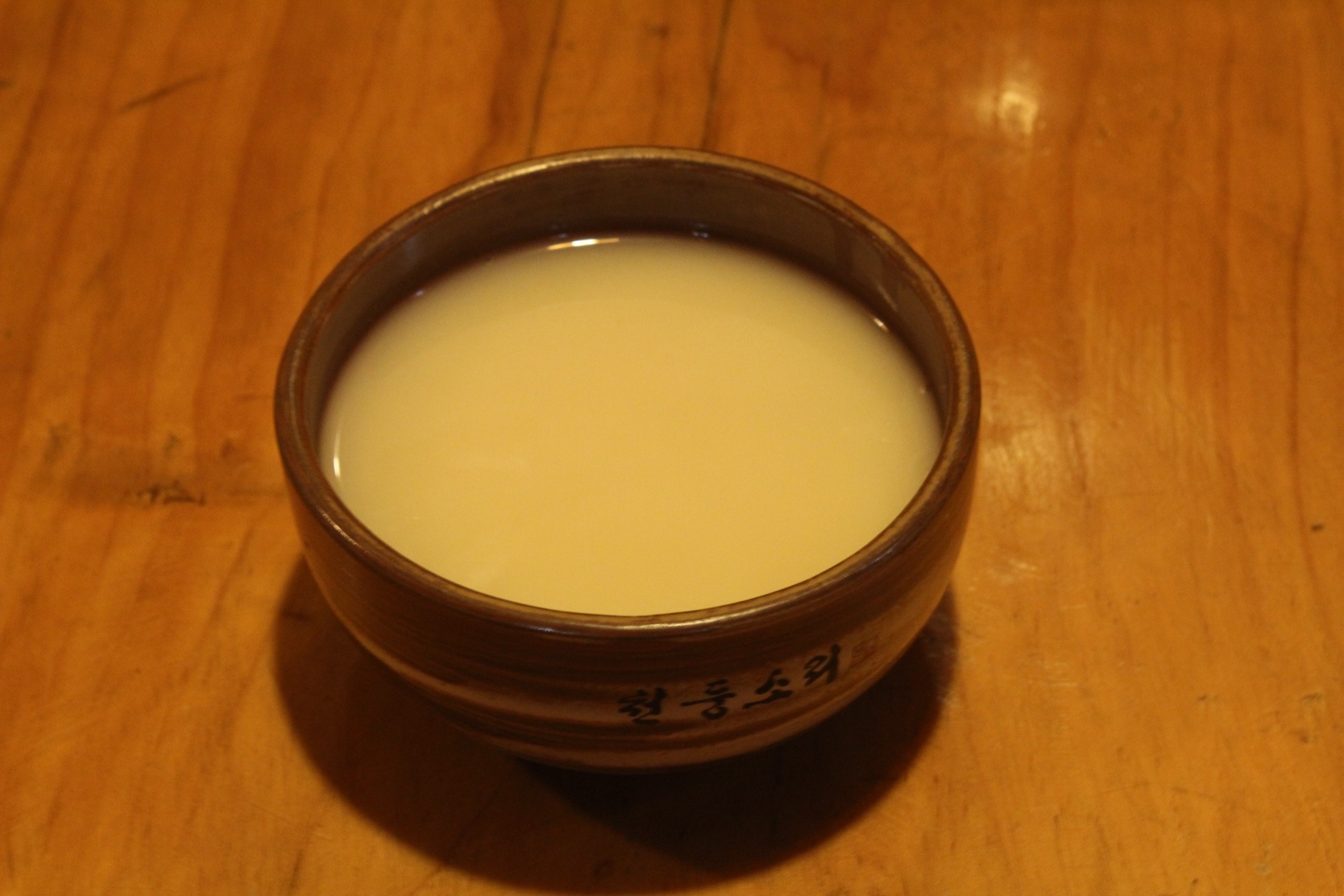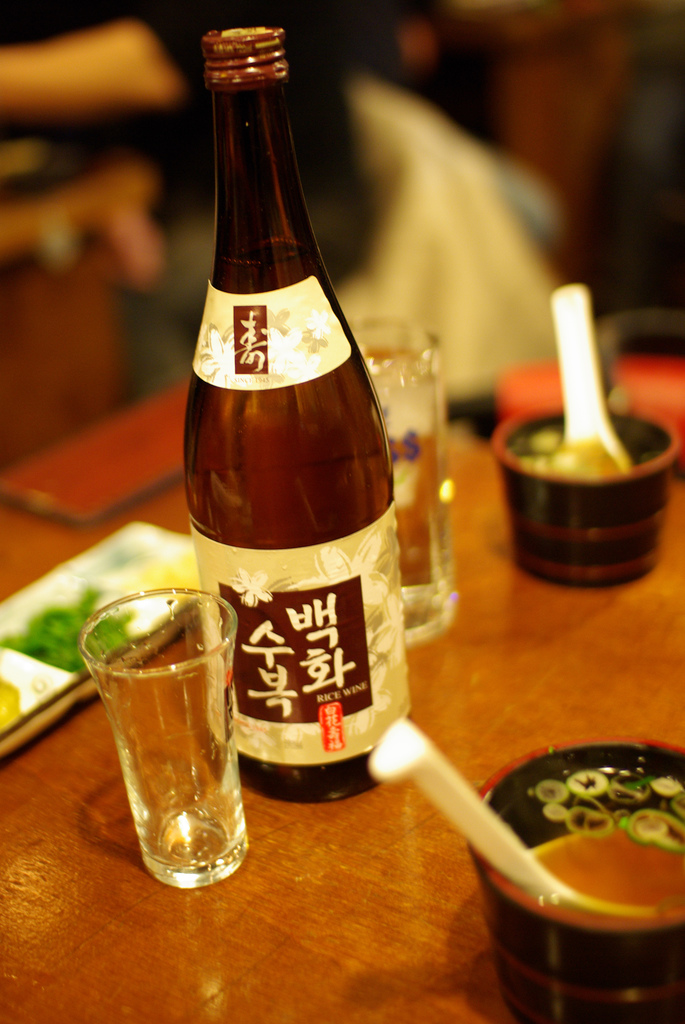|
Beopju
''Beopju'' () is a type of '' cheongju'' (clear rice wine). The name literally means "law liquor", as it is made following a fixed procedure. On 1 November 1986, a variety called ''Gyodong-beopju'' was designated by the government of South Korea as Intangible Cultural Property (No. 86-3). History ''Beopju'' is mentioned in '' Illustrated Account of Goryeo'', a 1124 book written by a Song Chinese envoy to Goryeo and '' History of Goryeo'', a 1451 Joseon book on history. Originally, it referred to the rice wines made with non-glutinous rice, for official or administrative use, such as for '' Jongmyo jerye'' (royal ancestral rite). Later, it also referred to the rice wines made around Buddhist temples. Today, the variety called ''Gyodong-beopju'', brewed with glutinous rice in the head-house of Gyerim Choe clan in Gyo-dong, Gyeongju, North Gyeongsang Province, is renowned. The variety was first made by Choe Gukjun, a Joseon Joseon (; ; Middle Korean: 됴ᇢ〯션� ... [...More Info...] [...Related Items...] OR: [Wikipedia] [Google] [Baidu] |
Korean Alcoholic Drinks
Korean cuisine has a wide variety of traditional alcoholic drinks, known as ''sul'' (). Many of these drinks end with the Sino-Korean word ''-ju'' (), and some end with the native Korean word ''-sul''. The Sino-Korean ''-ju'' is not used as an independent noun. There are an estimated 1,000 or more kinds of alcoholic drinks in Korea. Most are made from rice, and are fermented with the aid of yeast and ''nuruk'' (a wheat-based source of the enzyme amylase). Fruits, flowers, herbs, and other natural ingredients have also been used to craft traditional Korean alcoholic drinks. There are six distinct flavors: sweet, sour, pungent, roasted, bitter, and spicy. When the flavors are balanced, the alcohol is considered of good quality. Etymology There are several hypotheses regarding the origin of the word Sul, for one it is thought to have come from Chinese characters or Su-eul meaning Korean milk porridge (Korean word Tarakjuk). It can be understood that Sul must have derived from t ... [...More Info...] [...Related Items...] OR: [Wikipedia] [Google] [Baidu] |
Cheongju (wine)
''Cheongju'' (; literally "clear wine"), sometimes romanized as ''Chungju'', is a clear, refined rice wine of Korean origin. Names The word ''cheongju'' () consists of two characters: ''cheong'' () meaning "clear" and ''ju'' () meaning "alcoholic drink". It contrasts with ''takju'' (), as "tak" () means "turbid". The word ''takju'' usually refers to ''makgeolli'' (milky, unrefined rice wine). The hanja characters 淸酒 are the same as the kanji pronounced ''seishu'' used on the labels of sake. The native Korean word for "clear wine", ''malgeun-sul'' (), is also used to refer to ''cheongju''. Another name for ''cheongju'' is ''yakju'' (), which literally translates into "medicinal wine". History According to '' Things on Korea''—a 12th-century book on Korea written by Song Chinese scholar Sun Mu (孫穆)—the Goryeo people used non-glutinous rice to brew rice wine. Another 12th-century Chinese book, '' Illustrated Account of Goryeo'', reports that Korean rice wine th ... [...More Info...] [...Related Items...] OR: [Wikipedia] [Google] [Baidu] |
Gyo-dong, Gyeongju
Gyo-dong is a '' dong'' or neighborhood in the city of Gyeongju, North Gyeongsang province, South Korea. It is one of ''legal dong'' under its ''administrative dong'', Wolseong-dong's jurisdiction. The name, Gyo-dong originates from the fact that the area has had a ''hyanggyo'', government-managed Confucian academies during the Goryeo and Joseon dynasties. It belonged to Bunae-myeon, Gyeongju County (Gyeongju-gun) during the late period of the Joseon Dynasty. Gyo-dong was variously called Hyanggyotgol, Gyochon or Gyori at the times.교동 Gyo-dong 校洞 (in Korean) Dorurang Mountain ('' [...More Info...] [...Related Items...] OR: [Wikipedia] [Google] [Baidu] |
Encyclopedia Of Korean Culture
The ''Encyclopedia of Korean Culture'' is a Korean language encyclopedia published by the Academy of Korean Studies and DongBang Media Co. The articles in the encyclopedia are aimed at readers who want to learn about Korean culture and history, and were written by over 3,800 scholars and expert contributors — mainly associated with the Academy of Korean Studies. '' Munhwa Ilbo'' called it the most extensive encyclopedia of Korean studies. In 2001, the digital edition EncyKorea was published on CD-ROM and DVD. See also *''Doosan Encyclopedia'' *List of digital library projects *Lists of encyclopedias * List of encyclopedias by branch of knowledge *List of encyclopedias by language * List of historical encyclopedias *List of online encyclopedias This is a list of well-known online encyclopedias—i.e., encyclopedias accessible or formerly accessible on the Internet. The largest online encyclopedias are general reference works, though there are also many specialized ones. ... [...More Info...] [...Related Items...] OR: [Wikipedia] [Google] [Baidu] |
Munbae-ju
Munbaeju is a Korean traditional distilled liquor that is considered one of the finest Korean spirits. Its name consists of the words ''munbae'' ( 문배), which means "wild pear" ( ''Pyrus ussuriensis'' var. seoulensis), and ''ju'' ( 주; 酒), meaning "alcohol". This name is derived from its fruity scent from the wild pear, though no pear is used in its production. Ingredients and production ''Munbaeju'' is brewed from wheat, hulled millet, Indian millet, and ''nuruk'' (fermentation starter), then distilled. Origins Although it is South Korea's " Important Intangible Cultural Property Number 86-1", it originated from North Korea's Pyeongyang. Its origins are traced to the Goryeo Dynasty. The water used to produce Munbaeju comes from the Taedong River. A royal subject of Wang Geon presented him with home-brewed munbaeju, which his family had made with a secret recipe for generations. Wang Geon was so impressed with its taste, that he gave the subject a high-ranking position in ... [...More Info...] [...Related Items...] OR: [Wikipedia] [Google] [Baidu] |
Nuruk
''Nuruk'' () is a traditional Korean fermentation starter. It is used to make various types of Korean alcoholic beverages including '' takju'', ''cheongju'', and soju. It is an essential ingredient in Shindari and is mixed with rice.Nowicki, Stephen. Holt McDougal Biology. Orlando, FL: Holt McDougal, 2012. Print. Historically, it was used in a variety of provinces of Korea, including Jeju Island. Wheat, rice (of both the glutinous and non-glutinous types), and barley are used to make ''nuruk,'' either as whole grain or in the form of grits or flour. Wheat ''nuruk'' is the most common variety. The dry grain is moistened, shaped into a large cake, and hung up to ferment for 2‒4 weeks in an ondol room. The cake matures at a precise temperature until a mold forms. Origin ''Nuruk'' has been used in Korea since the period of the Three Kingdoms in the 3rd century CE, while similar fermentation starter, '' jiuqu'', was first made in China during the Warring States period beginning ... [...More Info...] [...Related Items...] OR: [Wikipedia] [Google] [Baidu] |
North Gyeongsang Province
North Gyeongsang Province ( ko, 경상북도, translit=Gyeongsangbuk-do, ) is a province in eastern South Korea. The province was formed in 1896 from the northern half of the former Gyeongsang province, and remained a province of Korea until the country's division in 1945, then became part of South Korea. Daegu was the capital of North Gyeongsang Province between 1896 and 1981, but has not been a part of the province since 1981. In 2016, the provincial capital moved from Daegu to Andong. The area of the province is , 19.1 percent of the total area of South Korea. Geography and climate The province is part of the Yeongnam region, on the south by Gyeongsangnam-do, on the west by Jeollabuk-do and Chungcheongbuk-do Provinces, and on the north by Gangwon-do Province. During the summer, North Gyeongsang Province is perhaps the hottest province in South Korea. This is helped by the fact that the province is largely surrounded by mountains: the Taebaek Mountains in the east and ... [...More Info...] [...Related Items...] OR: [Wikipedia] [Google] [Baidu] |
Clan
A clan is a group of people united by actual or perceived kinship and descent. Even if lineage details are unknown, clans may claim descent from founding member or apical ancestor. Clans, in indigenous societies, tend to be endogamous, meaning that their members can marry one another. Clans preceded more centralized forms of community organization and government, and exist in every country. Members may identify with a coat of arms or other symbol to show that they are an . Kinship-based groups may also have a symbolic ancestor, whereby the clan shares a "stipulated" common ancestor who serves as a symbol of the clan's unity. Etymology The English word "clan" is derived from old Irish meaning "children", "offspring", "progeny" or "descendants"; it is not from the word for "family" or "clan" in either Irish or Scottish Gaelic. According to the '' Oxford English Dictionary'', the word "clan" was introduced into English in around 1425, as a descriptive label for the organ ... [...More Info...] [...Related Items...] OR: [Wikipedia] [Google] [Baidu] |
Choe
Choi is a Korean family surname. As of the South Korean census of 2015, there were around 2.3 million people by this name in South Korea or roughly 4.7% of the population. In English-speaking countries, it is most often anglicized ''Choi'', and sometimes also ''Chey'', ''Choe'' or ''Chwe''. Ethnic Koreans in the former USSR prefer the form ''Tsoi'' (''Tsoy'') especially as a transcription of the Cyrillic Цой. Origin *According to Samguk Sagi, the Gyeongju clan originates from chief Sobeoldori (소벌도리, 蘇伐都利) of Goheochon (고허촌, 高墟村), one of six villages that united to found Silla; The Gyeongju clan traces their origin back to Choi Chiwon (857–10th century), a noted Korean scholar, philosopher, and poet of the late Unified Silla period (668–935). *One theory of origin suggests that Haeju clan's progenitor Choi Choong (최충, 崔沖, 984–1068) was given the surname 崔 during the reign of Goryeo king Mokjong. *The progenitor of the Chungju cla ... [...More Info...] [...Related Items...] OR: [Wikipedia] [Google] [Baidu] |




